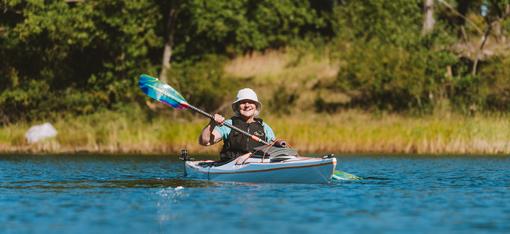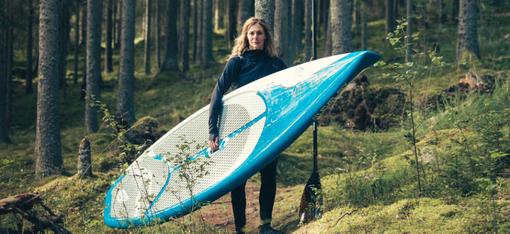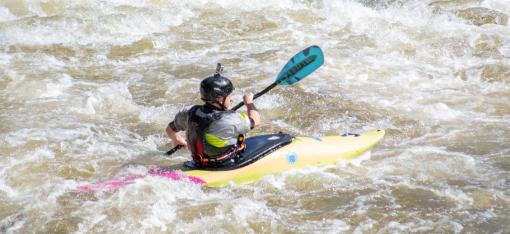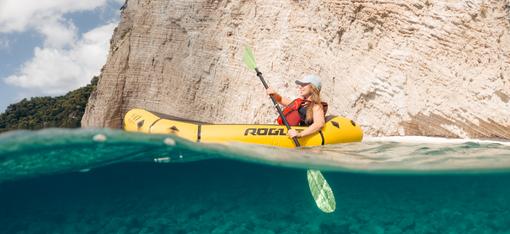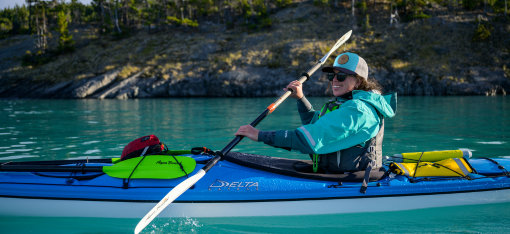23 Top Tips to Get You Stand-Up Paddle Boarding Quickly
11-minute read
Stand-up paddleboarding (also known as SUP) is a fantastic full-body workout that people of all ages can learn how to do and enjoy. We’ve collected 23 helpful tips to get you stand-up paddle boarding quickly.

A couple of key points before we begin:
- Like any physical activity, your fitness level matters. If you already exercise regularly and are in decent shape, learning how to SUP will be easier. That doesn't mean you won't be able to learn if you're not fit. But it does make some things harder than they need to be—like getting from your knees to your feet, balancing on the board or climbing on your board from the water after a fall.
- The type of water you learn on makes a difference. It's far easier to learn how to paddle board on a calm flat water lake than on a river with strong currents and hazards or on ocean waves.
- Spend some time practicing flat water or slow-river paddle boarding before you try SUP surfing, SUP yoga or whitewater SUP.
On to our list of top tips:
1. Know How to Swim
Even though you’ll be attached to your board by a leash and will wear a life jacket—SUP is a water sport. Know how to swim and you’ll not only enjoy it more, you’ll be safer.
When you’re comfortable in the water you won’t be afraid of falling in either, which you probably will do a few times as you learn! It’s quite easy to climb onto a paddle board from the water, so swimming can make your SUP experience even better on hot summer days.
If you're not yet a strong swimmer, consider staying in shallow water as you practice your SUP skills.
2. Practice on Solid Ground First
The easiest way to learn the technique of standing up on a paddle board for the first time is to learn on solid ground first. Get used to the motion of going from your knees to your feet while holding onto your paddle. Once you can do that in one fluid motion you're ready to try it on the water.
You want to be comfortable with the technique before attempting it on the unstable surface of the water.
3. Find a Good Spot to Launch
Give yourself as many advantages as you can with your water conditions. For example, when you first start out, choose a nice warm day in calm conditions when you’ll enjoy getting wet. Launch from a sandy, shallow beach at a body of water that’s warm enough to swim in.
Since you may end up in the water occasionally while you learn, stay away from mucky lake and river bottoms and rocky areas. If you don’t like swimming among water vegetation, steer clear of those areas, too.
4. Start on your knees
It’s easier to get used to the feel of the board on the water with a low center of gravity. So stay on your knees for a while when you first push out onto the water. Try one or two different paddle strokes and get used to how the board performs and maneuvers.

Start on your knees as you get used to the feel of the board on the water (photo courtesy of Sharon Brodin)
5. Stand to Your Feet in One Fluid Motion
Hopefully, you’ve already practiced this a few times on solid ground. When you’re ready to stand up, remember what that felt like. Get to a standing position in one fluid motion, bringing your paddle with you.
As you stand upright, plant your paddle in the water or in front of you on the board for extra stability. Just like a tripod or 3-legged stool, using your paddle as a “third leg” will help you balance on that unstable surface.
Practice standing up on your SUP in the water several times until it's easy for you.
6. Keep a Wide Stance
When you're starting in your kneeling position, look to be sure a knee is on either side of the handle that's in the middle of the board. Keep your knees wide, and then as you stand keep your feet wide, too.
Once you’ve stood up, it’s hard to move your feet into a different position. And if your feet are too close together you won’t be as stable, and therefore more likely to lose your balance

Keep a wide stance and use your paddle as a third “leg”
7. Know Where to Stand on the Board
Stand in the center of the board, straddling the middle handle. Keep your knees loose, not locked.
8. Know How to Hold the Paddle
The most common mistake beginning SUPers make is holding their paddle backwards. SUP paddles have a slight bend where the shaft meets the blade. The bent angle of the paddle’s “throat” should point toward you, so the “face” of the blade is forward:

It seems counter-intuitive, but it’s simple mechanics. With that slight bend, the paddle blade will complete each stroke with less drag on the water as you bring it out again each time. This means more efficiency and less fatigue for you than if your paddle is facing the wrong way.
Place one hand on top of the paddle grip and the other down the shaft waist or hip-high, where it’s comfortable for you.
9. Keep Your Momentum Going
Just like riding a bicycle, paddle boarding is easier when you’re in motion. As soon as possible after you stand up, get your paddle in the water and start moving. Then keep moving!
If you want to stop to look at something or chat with a friend, either keep your paddle blade in the water or rest it gently on the board in front of you. Remember the three-legged stool!

Attach the leash to your ankle or calf so your board never gets away from you (photo courtesy of Sharon Brodin)
10. Use the Leash
If you fall, the momentum will usually push your SUP board away from you. By the time you’ve surfaced, it could be many feet away—especially in windy conditions or if you’re in current.
So the leash is an important safety item. One end should be attached to the back of your board and the Velcro wrap on the other end should be around your ankle or calf. Be sure it’s tight enough that it won’t fall off if you end up in the water.
While it may seem inconvenient, you’ll be happy your board stayed within reach!
11. Learn How to Fall
When you’re learning to SUP, plan to fall. Have that expectation so you can relax and take it as it comes.
Practice falling away from the board. If you're on a hard paddle board (also called solid or rigid) you don't want to injure yourself. Inflatable paddle boards are much softer to land on, but it’s still good practice to fall away from it.
Also, practice hanging on to your paddle when you fall so you don’t lose it. While it will float, it could be 20 feet downstream or across a windy lake before you’re able to start swimming after it. Not a good scenario!

(photo courtesy of Emily Hendricks)
12. Practice Climbing Back on Your Board
Practice climbing back on your board until it becomes easy and you have more reason not to panic. To do this:
- Swim to one side of your board to the center
- Grab the handle with one hand and the far edge with the other.
- Kick your feet out behind you near the water’s surface (not below you). Give yourself a good kick and pull with your arms at the same time to boost your upper body onto the board.
- Swing around to face the front, get on your knees and then stand up when you’re ready.
If you’re wearing a traditional foam PFD, you might find it easier to take it off while you climb back on. Be sure to attach it to the bungees so it doesn’t float away. Then you can put it back on once you feel stable again.
(Inflatable boards a usually thicker than solid boards and so it'll be a bit more of a challenge to climb on from the water—but still very doable.)
13. Use Long, Straight Strokes—Don’t “Poke”
Don’t poke at the water with your paddle, but reach out in front of you with your knees bent, plant the blade in the water and pull it back to your feet as you straighten up.
Use your core muscles and upper body with each stroke, not just your arms. You’ll get more efficient, powerful strokes and put less strain on your shoulders.
14. Look Ahead, Not Down
Almost all beginning paddle boarders keep their eyes down on their feet while they paddle. It’s understandable, as you’re trying to keep track of several things at once.
But keep your eyes focused on the water and horizon ahead of you instead. It’ll be easier to keep your balance and stability.

Look ahead of you while you paddle, not down at your feet
15. Relax!
Relax your body, keep your legs and knees flexible and feel the water movement under you. If you encounter waves or wake from motor boats, allow your knees to move up and down with the motion of the water.
Remember, you’re doing this to have fun! Enjoy it. If you need to, take a break by kneeling or sitting on your board for a while.
16. Learn Paddle Strokes
If SUP is an activity you want to become good at, the best way to increase your skill level is to learn basic paddle strokes. Learn to steer from either side, turn, brace and stop with ease.
If you already know how to canoe or kayak, you’ll have a head start with paddle technique on a SUP board. If this is your first paddling activity, consider getting proper instruction to decrease the learning curve.
17. Learn and Practice Bracing Techniques
“Bracing” is when you use the face of the paddle blade on the water to help you regain your balance when you feel tippy.
There are a couple different simple braces you can practice until they become second nature. Check out this short article and video from our friends at Paddling.com.

It’s always OK to take a break to relax for a while! (photo courtesy of Sharon Brodin)
18. Check the Weather Forecast before You Head Out
Like any outdoor activity, the weather can make or break your fun and even your safety. Check the forecast before you head out for temperatures, wind speed and direction, and possible threatening storms.
Paddle boarding in high winds isn’t much fun, especially for beginners. And if you hear thunder it’s time to get off the water. You don’t want to risk a nearby lightning strike.
19. Prepare for Wind and Waves
If the weather and water get to be more than you bargained for, you’ll be more stable if you drop to your knees to paddle back to shore. In high winds, standing up is like having a sail—great if it’s pushing you in the right direction. Not so great if you’re struggling against it. Getting on your knees removes some of that resistance.
If you meet waves like boat wake, turn your board to meet them head-on and you’ll stay more stable than if the waves hit the side of your board. You can drop to your knees for extra stability.
20. Dress for the Air AND Water Temperature
Your body loses heat rapidly when you’re wet. That’s great news when the air is hot and the water is refreshing. But it can be dangerous with cold air temps and especially with cold water temps.
Hypothermia is no joke. Unless you’re wearing a wetsuit or a dry suit, stay off very cold water—or stay very close to shore. Safety is your first consideration.
21. Wear Your PFD
There are plenty of comfortable PFD options out there to choose from, even self-inflating ones that have a very low-profile. This is especially important on big bodies of water like the ocean, on rivers with current and in windy, wavy conditions. Again, safety is your first consideration.
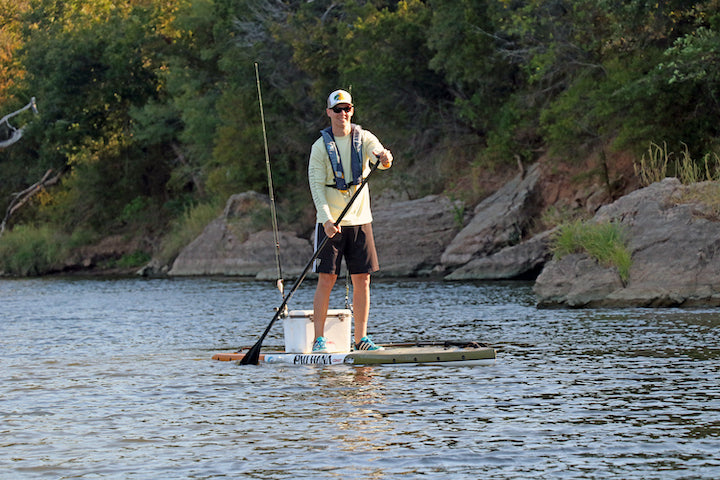
If you don’t like a bulky PFD, invest in an inflatable one like this one for a much lower profile
22. Take a Lesson or Two
All of these beginner’s tips can be nailed down in a lesson or two from an experienced friend of professional SUP instructor. It’s really worth it to invest in a lesson or two before heading out on your own.
23. Practice
Then practice, practice, practice. Get out in the water on a paddleboard as often as you can. In no time at all you’ll feel comfortable and able to enjoy the beauty of the water and your surroundings.
You can also practice on different boards: try both inflatable and solid to feel the difference. Try a touring board, an all-around board and even a board designed for yoga.
24. BONUS TIP: Use a Good Paddle
Lots of paddle boards—especially budget and mid-range boards—come with a paddle when you buy one. But in almost every case, this paddle will be heavy and feel clunky in your hands.
It’s so worth it to invest in a lightweight, comfortable and well-designed paddle that's sized right for you. Think about it: the paddle is what you’ll hold in your hands all day long. It’s your motor. It’s your connection to the water. You’ll be amazed at the difference a good paddle makes.

We have SUP paddles from aluminum to fiberglass to carbon. They come in 1-piece, 2-piece and 4-piece. Our best paddles are so feather-light you’ll hardly notice you’re lifting them. Take a look at our collection here.
(Thanks to the following sources: David De Haan from Stand Up Paddleboards Revew; Hawaiian Paddlesports blog; Isle Surf & SUP blog)
Let our friendly Customer Service team help you choose your new SUP paddle today: 715-755-3405 • sales@aquabound.com
More for you...
- How to Choose a SUP Board
- SUP: Inflatable vs. Solid Paddleboard
- Aqua Bound’s Long Distance SUP Paddles

